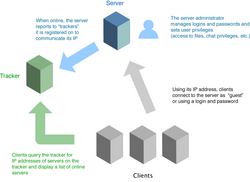Hotline Communications
Hotline Communications Limited (HCL) was a software company founded in 1997 based in Toronto, Canada. Hotline Communications' main activity was the publishing and distribution of the multi-application, peer-to-peer communication software suite Hotline Connect (often referred to as Hotline or HL). Hotline Communications went out of business in 2001, and all its assets were acquired in 2002 by Hotsprings Inc., a new company formed by some ex-employees and shareholders. Hotsprings Inc. has since also abandoned development of the Hotline Connect software suite; the last iteration of Hotline Connect was released in December 2003.
History
Hotline was designed in 1996 by Australian programmer Adam Hinkley, then 17 years old, as a Mac OS application. The source code for the Hotline applications was based on a class library, "AppWarrior" (AW), which Hinkley wrote. AppWarrior would later become litigious, as Hinkley wrote parts of it while he was employed by an Australian company, Redrock Holdings. In 1997, Canadian Jason Roks approached Adam Hinkley and encouraged him to move to Toronto, where Hotline Communications, Ltd. was created. The same year, Hotline won the "Macworld Best of the Show" award at the Boston MacWorld Expo. At the time, the company's main objective was to release a stable Windows-compatible version to reach a wider audience.
However, after a few months, Hinkley felt his expectations had not been met by his Hotline Communications associates, and left the company, encrypting source files for Hotline on HCL's computers. Lawsuits against Hinkley were filed by both Hotline Communications and Redrock, and Hinkley lost copyright of his "AppWarrior" library as well as rights over the "Hotline" software. The legal battle and Hinkley's case drew some media attention, especially on the Internet.
At the end of the 1990s, Hotline started to gradually fade, as other peer-to-peer systems not restricted by Hotline's client-server scheme became increasingly popular. Many early Hotline users felt sympathy for Hinkley and viewed Hotline Communications with a bad eye and the Hotline Connect suite did not sell well. In September 2001, Hotline Communications announced development of version 2.0 of the Hotline suite had been stopped, beta versions of which had not been well received by the community, and laid off most of its employees. In mid-October of the same year, the company announced the re-hire of their engineering team "in anticipation of the release of Hotline 2.0" on their website (http://www.bigredh.com/ - offline as of April 2005). However, no stable build of Hotline 2.0 was ever released.
Hotline Connect software suite

The Hotline applications were distributed as shareware and combined chat, message board and file sharing capabilities and operate using a peer-to-peer model. As such, Hotline is sometimes credited with being a pioneering file sharing application, as it predates software like Napster and Gnutella. The key difference between Hotline and modern peer-to-peer applications is that the client and server applications are separate and that end users can choose who may connect to their server as well as set different privileges for different users.
Hotline Connect consisted of three applications, distributed separately (via Internet download or on promotional CDs):
- Hotline Client: an application used to access Hotline servers set up by users running the Hotline Server software. Hotline Connect users with a client installed could connect to servers they knew using the host's IP address.
- Hotline Server: an easily set up server application.
- Hotline Tracker: a name server, used to keep track of the IP addresses of several Hotline servers.
References
Company and product history
- "Hotline to the Underground", Salon.com Archive. Accessed on April 3, 2005.
- "Wayback Machine search results for 'bigredh.com'", Internet Archive (website) Wayback Machine. Accessed on April 7, 2005. — A chronicle of the different versions of the bigredh.com website. "BigRedH.com" was Hotline Communication's website and e-commerce platform from June 2001 on. E-commerce "service provider" Digital River designed the original website (Digital River press release).
- "Wayback Machine search results for 'hotspringsinc.com'", Internet Archive Wayback Machine. Accessed on April 7, 2005. — A chronicle of the different versions of the hotspringsinc.com website.
Legal battle
- "Hotline's Civil War", Salon.com Archive. Accessed on April 3, 2005.
- "Employment Law, Intellectual Property Law and the New Economy" (radio program transcript), The Law Report (website), Australian Broadcasting Corporation Radio National (website). Accessed April 7, 2005. — Discussion of the Hotline vs. Hinkley legal battle in the broader context of intellectual property law in Australia.
- "Adam Hinkley's IP Hindsights", Slashdot.org. Accessed on April 7, 2005. — Slashdot discussion about original Hotline programmer Adam Hinkley's legal battle against his former Hotline Communications, Ltd. associates.
